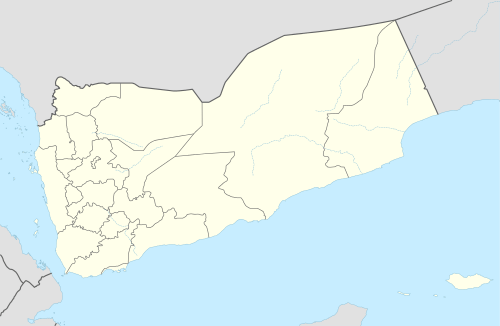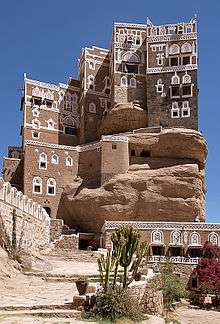Shibam
| Shibām (Arabic: شِـبَـام)[1] Shibâm Ḥaḍramawṫ (Arabic: شِـبَـام حَـضْـرَمَـوْت)[2][3] | |
|---|---|
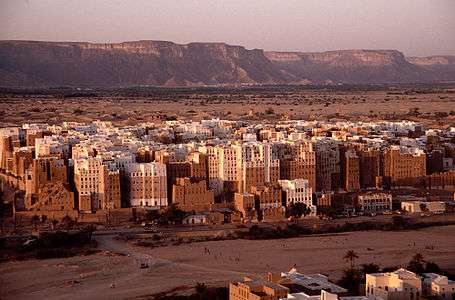 | |
|
Nickname(s): Chicago of the Desert (Arabic: شِـيـكَاغـو الـصَّـحْـرَاء) Manhattan of the Desert (Arabic: مَـانْـهَـاتَـن الـصَّـحْـرَاء)[1][2] | |
| Coordinates: 15°55′36.98″N 48°37′36.01″E / 15.9269389°N 48.6266694°E | |
| Country |
|
| Governorate | Hadhramaut |
| District | Shibam[4] |
| Population | |
| • Total | 7,000 |
| Time zone | GMT+3 |
| Official name | Old Walled City of Shibam |
| Type | Cultural |
| Criteria | iii, iv, vi |
| Designated | 1982; endangered as of 2015 |
| Reference no. | 192 |
| State Party |
|
| Region | Arab States |
Shibam (Arabic: شِـبَـام, translit. Šibām), often referred to as Shibam Hadhramaut (Arabic: شِـبَـام حَـضْـرَمَـوْت)[2][3] is a town in Yemen. With about 7,000 inhabitants, it is the seat of the District of Shibam[4] in the Governorate of Hadhramaut. Being famous for its mudbrick-made high-rise buildings, it is referred to as the Chicago of the Desert (Arabic: شِـيـكَاغـو الـصَّـحْـرَاء),[2] or Manhattan of the Desert (Arabic: مَـانْـهَـاتَـن الـصَّـحْـرَاء).[1]
History
The first known inscription about the city dates from the 3rd century CE.[5] It was the capital of the Hadramawt Kingdom.
Geography
The town is located in the central-western area of Hadhramaut Governorate, in the desert of Ramlat al-Sab'atayn. Its main road links Sana'a and other cities of western Yemen to the far eastern territories. Nearest towns are Seiyun, seat of an airport, and Tarim, both in the east. Another road, departing from the village of Alajlanya, in the west, links Shibam to Mukalla, governorate's capital, located by the Indian Ocean.
Climate
Shibam has a hot desert climate (Köppen: BWh). At an average temperature of 28.0 °C, June is the hottest month of the year. January is the coldest month, with temperatures averaging 18.6 °C (65.5 °F).
| Climate data for Shibam | |||||||||||||
|---|---|---|---|---|---|---|---|---|---|---|---|---|---|
| Month | Jan | Feb | Mar | Apr | May | Jun | Jul | Aug | Sep | Oct | Nov | Dec | Year |
| Average high °C (°F) | 24.0 (75.2) |
25.3 (77.5) |
27.4 (81.3) |
29.5 (85.1) |
31.8 (89.2) |
33.4 (92.1) |
32.5 (90.5) |
31.8 (89.2) |
30.8 (87.4) |
29.0 (84.2) |
26.7 (80.1) |
25.3 (77.5) |
29 (84.1) |
| Daily mean °C (°F) | 18.6 (65.5) |
19.9 (67.8) |
22.1 (71.8) |
24.3 (75.7) |
26.7 (80.1) |
28.0 (82.4) |
27.5 (81.5) |
26.9 (80.4) |
26.0 (78.8) |
23.3 (73.9) |
20.8 (69.4) |
19.8 (67.6) |
23.7 (74.6) |
| Average low °C (°F) | 13.3 (55.9) |
14.6 (58.3) |
16.9 (62.4) |
19.2 (66.6) |
21.7 (71.1) |
22.7 (72.9) |
22.6 (72.7) |
22.1 (71.8) |
21.3 (70.3) |
17.6 (63.7) |
14.9 (58.8) |
14.3 (57.7) |
18.4 (65.2) |
| Average precipitation mm (inches) | 8 (0.31) |
5 (0.2) |
17 (0.67) |
10 (0.39) |
3 (0.12) |
0 (0) |
3 (0.12) |
4 (0.16) |
1 (0.04) |
0 (0) |
5 (0.2) |
8 (0.31) |
64 (2.52) |
| Source: Climate-Data.org[6] | |||||||||||||
Architecture
Overview
Shibam, which is now a UNESCO World Heritage Site, is known for its distinct architecture. The houses of Shibam are all made out of mud brick, and about 500 of them are tower blocks, which rise 5 to 11 stories high,[7] with each floor having one or two rooms.[8] This architectural style was used in order to protect residents from Bedouin attacks. While Shibam has been in existence for an estimated 1,700 years, most of the city's houses originate from the 16th century. Many, though, have been rebuilt numerous times in the last few centuries.
Shibam is often called "the oldest skyscraper city in the world".[5] It is one of the oldest and best examples of urban planning based on the principle of vertical construction.[9] The city has some of the tallest mud buildings in the world, with some of them over 30 m (98 feet) high,[10] thus being early high-rise apartment buildings. In order to protect the buildings from rain and erosion, the walls must be routinely maintained by applying fresh layers of mud.
The nearby town of Tarim contains the tallest structure in the Wadi Hadhramaut valley, the mudbrick minaret of the Al-Mihdhar mosque. It stands at a height of approximately 53.53 metres (174 feet).[8] This is the tallest minaret in the southern Arabian peninsula.[11]
Threats
The mudbrick buildings are frequently threatened by wind, rain, and heat erosion, and require constant upkeep in order to maintain their structures. The city was heavily affected by flooding from a tropical cyclone in 2008.[12] The foundations of many of the buildings in the city were compromised by the flood waters, eventually leading to their collapse.[13] It was also the target of an Al Qaeda attack in 2009.[14][15]
In 2015, Shibam was added to the list of World Heritage sites in Danger when violent civil war erupted in Yemen. Historic buildings were significantly damaged during heavy bombing in Sana'a, and remain at risk from armed conflict.[16][17]
Gallery
- City gate
- View of some "skyscrapers"
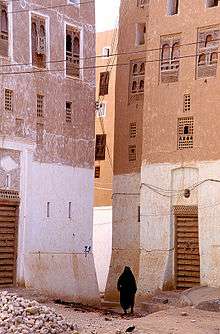 Two buildings on a street inside the town
Two buildings on a street inside the town.jpg) Street view
Street view.jpg) Architecture pattern
Architecture pattern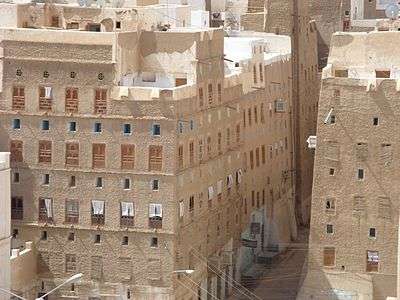 Shibam buildings with balconies
Shibam buildings with balconies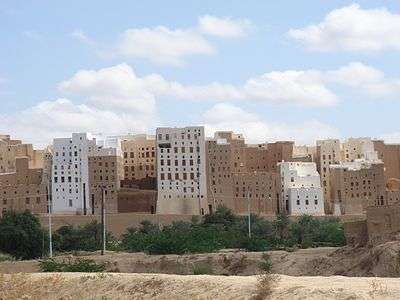 View of Old Walled City of Shibam
View of Old Walled City of Shibam
See also
References
- 1 2 3 4 5 6 "The Ancient City of Shibam: The Manhattan of the Desert". Weather.com. 2013-11-09. Retrieved 2018-03-22.
- 1 2 3 4 "مدينة شبام حضرموت "شيكاغو الصحراء"". Al-Bayan (in Arabic). 2012-07-30. Retrieved 2018-03-22.
- 1 2 "بلدة شبام حضرموت". Mawdoo3.com (in Arabic). 2017-04-06. Retrieved 2018-03-22.
- 1 2 "Districts of Yemen". Statoids. Retrieved October 21, 2010.
- 1 2 "Wadi Hadramowt and walled city of Shabam". ShibamOnline.net. Retrieved 2010-01-03.
- ↑ "Climate: Shibam". Retrieved October 2017. Check date values in:
|accessdate=(help) - ↑ Helfritz, Hans (April 1937). "Land without shade". Journal of the Royal Central Asian Society. 24 (2): 201–16. doi:10.1080/03068373708730789.
- 1 2 Jerome, Pamela; Chiari, Giacomo; Borelli, Caterina (1999). "The Architecture of Mud: Construction and Repair Technology in the Hadhramaut Region of Yemen". APT Bulletin. 30 (2–3): 39–48 [44]. doi:10.2307/1504639. JSTOR 1504639.
- ↑ Old Walled City of Shibam, UNESCO World Heritage Centre
- ↑ Shipman, J. G. T. (June 1984). "The Hadhramaut". Asian Affairs. 15 (2): 154–162. doi:10.1080/03068378408730145.
- ↑ Bamford, James (2009), The Shadow Factory: The Ultra-Secret NSA from 9/11 to the Eavesdropping on America, Random House, Inc., p. 9, ISBN 0-307-27939-1
- ↑ "Death Toll Mounts In Tropical Storm". CBS13.com. 2008-10-26. Archived from the original on 2009-03-22. Retrieved 2008-10-26.
- ↑ "Historic Town of Shibam Hadramout Escapes Flooding Largely Unscathed". ITN Source. November 3, 2008.
- ↑ "Al Qaeda blamed for Yemen attack". CNN. 2009-03-16. Retrieved 2009-04-26.
- ↑ "Al-Qaeda in Yemen:Political, Social and Security Dimensions". Yemen Post. 2009-04-12. Retrieved 2009-04-26.
- ↑ "List of World Heritage in Danger: The 54 properties which the World Heritage Committee has decided to include on the List of World Heritage in danger in accordance with Article 11 (4) of the Convention". UNESCO World Heritage Centre. 2015. Retrieved 2017-04-30.
- ↑ Bokova, Irina (2015-05-12). "UNESCO Director-General calls on all parties to protect Yemen's cultural heritage". UNESCO World Heritage Centre. Retrieved 2017-04-30.
In addition to causing terrible human suffering, these attacks are destroying Yemen’s unique cultural heritage, which is the repository of people’s identity, history and memory and an exceptional testimony to the achievements of the Islamic Civilization.
External links
| Wikimedia Commons has media related to Shibam. |
| Wikivoyage has a travel guide for Shibam. |
- Shibamonline.net
- Shibam at Archnet.org
- World Heritage Site
- Official website of the Al-Quaiti Royal Family of Hadhramaut
- Shibam at TravelAdventures.org
- Shibam, Yemen - Ciudad de Tierra at YouTube
- Shibam at YouTube
- اليمن ـ شبام حضرموت (in Arabic)
- Shibam / Shabwa
